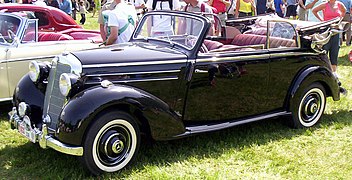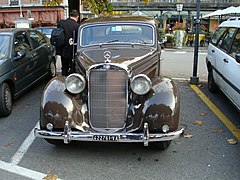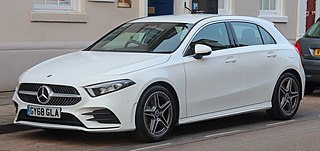
The Mercedes-Benz A-Class is a subcompact car produced by the German automobile manufacturer Mercedes-Benz as the brand's entry-level vehicle. The first generation was introduced in 1997, the second generation (W169) in late 2004 and the third generation (W176) in 2012. The fourth generation model (W177), which was launched in 2018, marked the first time the A-Class was offered in the United States and Canada. This fourth generation A-Class is also the first to be offered both as a hatchback (W177) and sedan (V177).
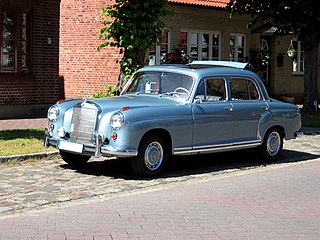
The Mercedes-Benz W128 is a 6-cylinder luxury car produced by Mercedes-Benz from 1958 to 1960 and marketed as the Mercedes-Benz 220 SE. It was available in sedan, coupé, or cabriolet body styles, and it was the last new model of the "Ponton" range which had design and styling roots beginning in 1953 with the Mercedes-Benz 180 sedan. It was largely identical to its 220 S predecessor, except for having petrol injection, 'Einspritzung' in German, reflected in the additional E in its 220 SE designation.
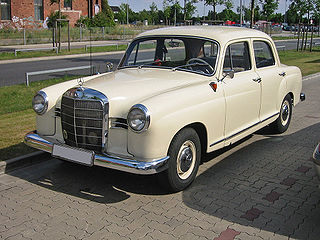
The Mercedes-Benz W120 and Mercedes-Benz W121 are technically similar inline-four cylinder sedans made by Daimler-Benz. The W120 was first introduced by Mercedes-Benz in 1953. Powered initially by the company's existing 1.8 liter M136 engine, it was sold as the Mercedes-Benz 180 through 1962. From 1954, Mercedes-Benz also offered the W120 with a diesel engine as the Mercedes-Benz 180 D. The Mercedes-Benz W121 was introduced as the Mercedes-Benz 190 in 1956, powered by a 1.9 liter M121 engine. From 1958, the W121 was also offered with an OM621 engine, sold as the Mercedes-Benz 190 D through 1961.

The W110 was Mercedes-Benz's entry level line of midsize automobiles in the mid-1960s. One of Mercedes' range of "Fintail" models, the W110 initially was available with either a 1.9 L M121 gasoline or 2.0 L OM621 diesel inline-four. It was introduced with the 190c and 190Dc sedans in April 1961, replacing the W120 180c/180Dc and W121 190b/190Db.

The Mercedes-Benz C111 was a series of experimental automobiles produced by Mercedes-Benz in the 1960s and 1970s. The company was experimenting with new engine technologies, including Wankel engines, diesel engines, and turbochargers, and used the basic C111 platform as a testbed. Other experimental features included multi-link rear suspension, gull-wing doors and a luxurious interior with leather trim and air conditioning.

The Mercedes-Benz W111 was a chassis code given to a range of Mercedes-Benz vehicles produced between 1959 and 1971, including four-door saloons (1959-1968) and two-door coupés and cabriolets. Their bodywork featured distinctive tailfins that gave the models their Heckflosse nickname — German for "fintail".

The Mercedes-Benz "Ponton" series are a range of sedans / saloon car models from Daimler-Benz, introduced starting in 1953, and subsequently nicknamed 'Ponton', referring to its ponton styling, a prominent styling trend that unified the previously articulated hood, body, fenders and runnings boards into a singular, often slab-sided envelope. At the time, Mercedes itself did not refer to any of its cars using the nickname.

The Mercedes-Benz W136 was Mercedes-Benz's main line of inline-four cylinder motorcars from the mid-1930s into the 1950s. The model 170 V made its public debut as successor to the W15 Typ 170 in February 1936. Between 1936 and 1939 it was Mercedes' top selling model.
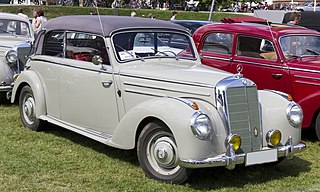
The Mercedes-Benz W187 is a luxury car produced by Mercedes-Benz from 1951 to 1955. Introduced at the Frankfurt Motor Show in April 1951, the W187 was powered by a single overhead camshaft inline six-cylinder M180 engine and available as a saloon, coupé, and cabriolet, all designated with the 220 model name.
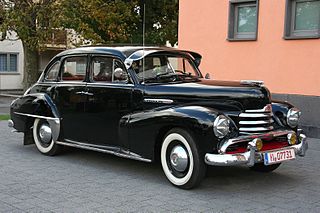
The Opel Kapitän is a luxury car made in several different generations by the German car manufacturer Opel from 1938 until 1970.

The Borgward Hansa 1500 is a medium-sized automobile manufactured by the Bremen based auto-manufacturer Carl F. W. Borgward GmbH from 1949 until 1954. It was first presented at the Geneva Motor Show in March 1949 and production commenced on 13 October 1949. The similar Hansa 1800 was introduced in 1952. The Hansa was replaced by the Borgward Isabella in 1954.

The Mercedes-Benz W15 is an automobile produced by Mercedes-Benz from 1931 to 1936. Regarded today as a mid-size family car, it was given the chassis designation W15, and sold as the Typ 170 in four-door "Limousine" (sedan/saloon) and Cabriolet forms.

The Opel Rekord D series is an executive car that replaced the Rekord C on Opel's Rüsselsheim production lines during the closing weeks of 1971 and launched on the West German market at the start of 1972. It shared its wheelbase and inherited most of its engines from its predecessor, but the bodies were completely new. Also new, announced in September 1972, was the option of a diesel powered Opel Rekord. Early advertising and press material called the new car the "Opel Rekord II" but in due course, the "Rekord II" appellation was quietly dropped and the Rekord D was replaced at the end of the 1977 summer holiday shut down by the Opel Rekord E.

The Mercedes-Benz Typ 230 n was introduced by Mercedes-Benz in 1937 as a successor to the Typ 230 . It was one of several models over the space of nearly eight decades to be sold with a name along the lines "Mercedes-Benz 230", and is therefore in retrospect more normally named according to its internal works designation as the Mercedes-Benz W 143.

The Mercedes-Benz OM 636 is a diesel engine that was produced by Daimler-Benz from 1948 until 1990. Being the successor to the OM–138, the OM–636 has been used both as a passenger car engine and as an industrial engine. It saw its first use in the Boehringer Unimog in 1948, prior to its official introduction in the 1949 Mercedes-Benz W–136. Throughout the 1950s, the OM–636 was widely used in the Mercedes-Benz W 120. In 1958, it was succeeded by the OM 621 passenger car engine. However, after the introduction of the OM 621, the OM 636 was kept in production for industrial vehicles such as small lorries, boats, and combine harvesters, until 1990.
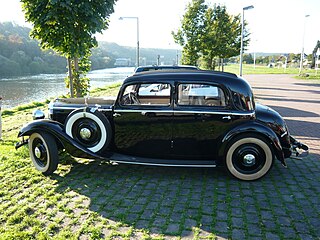
The Mercedes-Benz W 21 was a six-cylinder passenger car launched in 1933 using the name Mercedes-Benz Typ 200. It was one of several Mercedes-Benz models known, in its own time, as the Mercedes-Benz 200 and is therefore in retrospect more commonly referred to using its Mercedes-Benz works number, “W21”.

Mercedes-Benz W202 is the internal designation for a compact sedan/saloon manufactured and marketed by Mercedes-Benz 1993–2000, as the first generation of the C-Class, now in its fifth generation. Replacing the 190 series/W201 in June 1993, the C-Class sedan was Mercedes' entry-level model until 1997, when the company launched the A-Class. Production reached 1,847,382 over model years 1994–2000.

The Mercedes-Benz W205 is the fourth generation of the Mercedes-Benz C-Class which was produced by Daimler AG between 2014 and 2021. The W205 C-Class was preceded by the W204 C-Class and superseded by the W206 C-Class. The fourth-generation C-Class was available in sedan (W205), station wagon/estate (S205), coupe (C205), cabriolet (A205) and long-wheelbase sedan (V205) body styles.

The Mercedes-Benz W206 is the fifth generation of the Mercedes-Benz C-Class which is produced by Mercedes-Benz Group AG since 2021. It replaces the W205 C-Class which has been produced since 2014. The fifth-generation C-Class is available in sedan (W206), station wagon/estate (S206), and long-wheelbase sedan (V206) body styles. The W206 C-Class is based on the Mercedes MRA II rear-wheel drive modular platform also used by the W223 S-Class.
The Mercedes-Benz M08 engine is a naturally-aspirated and supercharged, 4.6-liter and 5.0-liter, straight-8 engine, designed, developed and produced by Mercedes-Benz; between 1928 and 1940.


